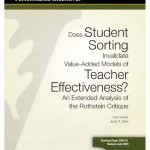Does Student Sorting Invalidate Value-Added Models of Teacher Effectiveness? An Extended Analysis of the Rothstein Critique
Value-added modeling continues to gain traction as a tool for measuring teacher performance. However, recent research (Rothstein, 2009, forthcoming) questions the validity of the value-added approach by showing that it does not mitigate student teacher sorting bias (its presumed primary benefit). Our study explores this critique in more detail. Although we find that estimated teacher effects from some value-added models are severely biased, we also show that a sufficiently complex value-added model that evaluated teachers over multiple years reduces the sorting-bias problem to statistical insignificance. One implication of our findings is that data from the first year or two of classroom teaching for novice teachers may be insufficient to make reliable judgments about quality. Overall, our results suggest that in some cases value-added modeling will continue to provide useful information about the effectiveness of educational inputs.
To read this paper, please click here.

Connect with Vanderbilt
©2025 Vanderbilt University ·
Site Development: University Web Communications